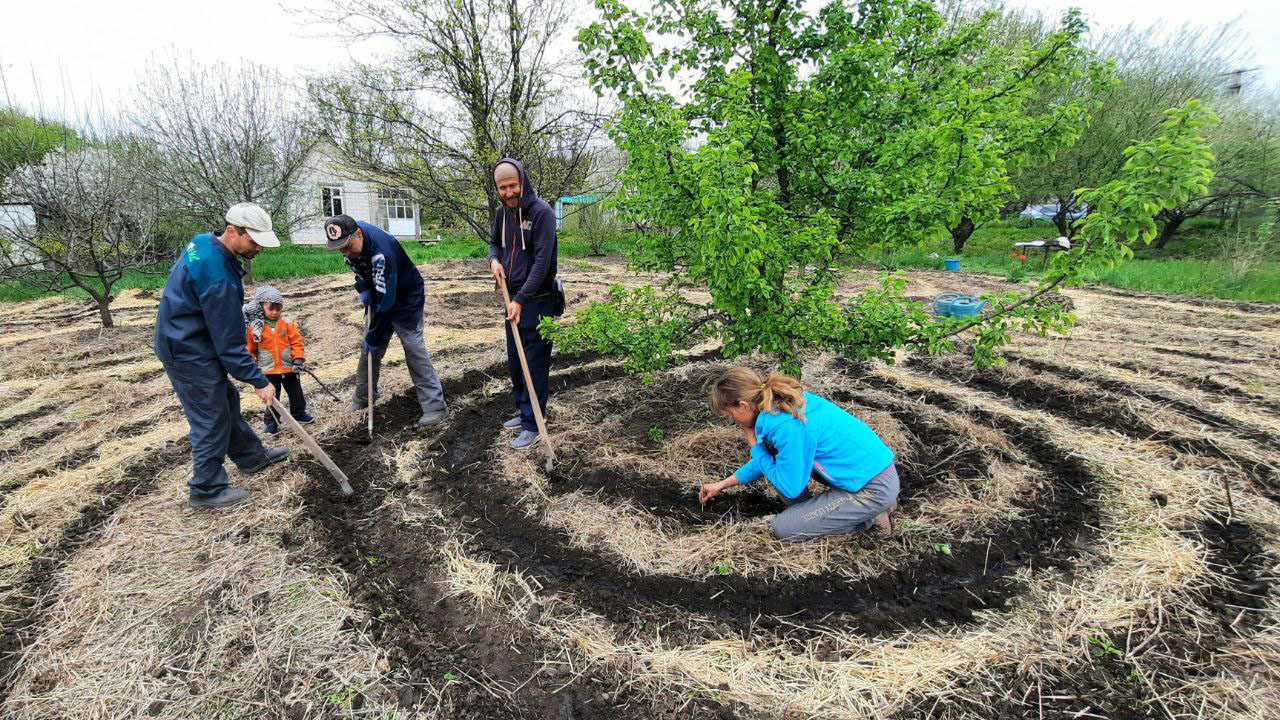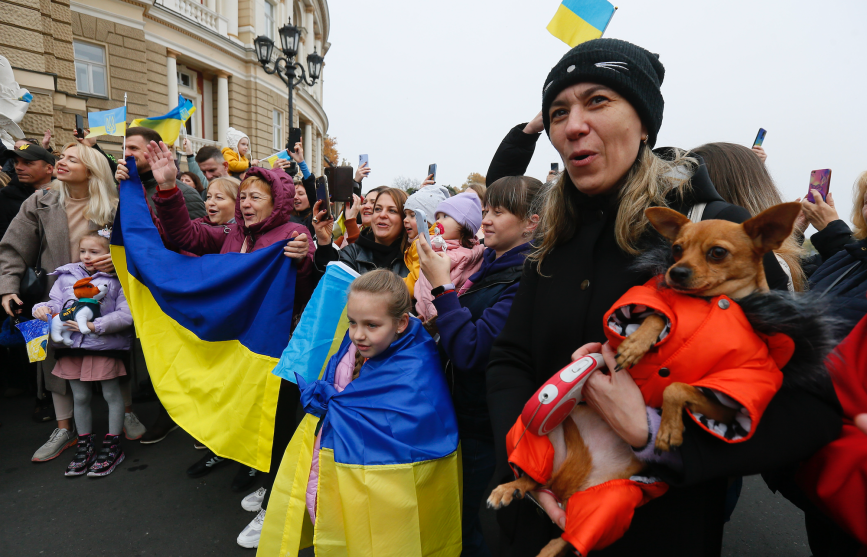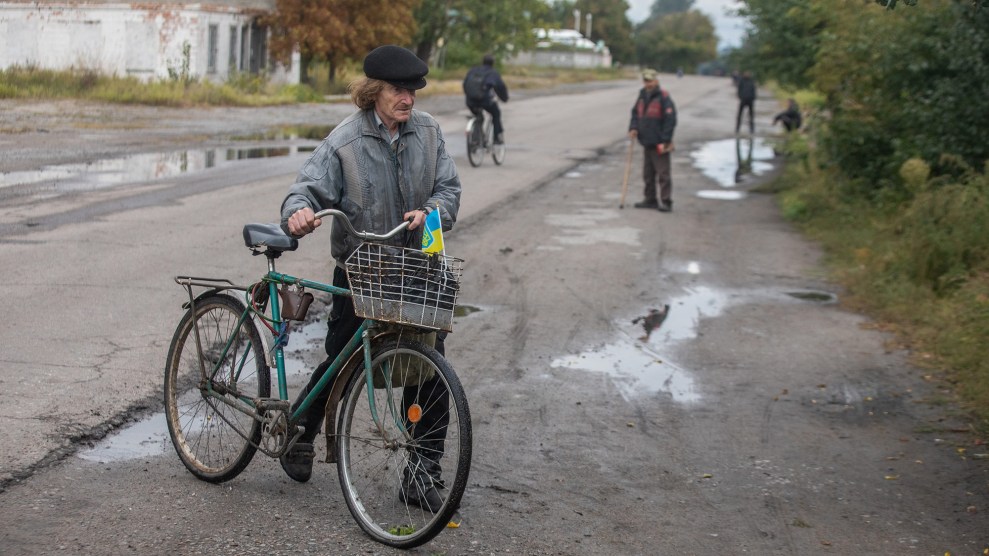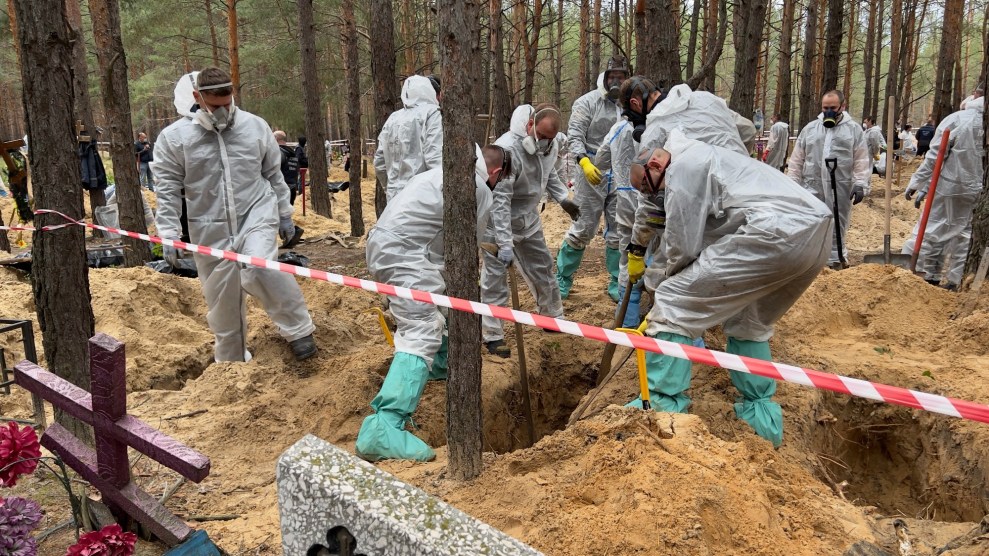After waking to the sound of explosions on February 24, 2022, the morning of Russia’s invasion of Ukraine, Anastasiya Volkova knew that she and her family had to leave Kyiv. They were visiting the city from their home, an ecovillage, in the Ukrainian countryside two hours south of the capital, far from where the sound of bombs could be heard.
With no car, Volkova, her husband, and young daughter listened to the ongoing assault and waited for her parents, who at that time lived in Kyiv, to pick them up. Finally, they arrived and together the three generations fled, heading for an area where eight other families had, as she put it, “moved from the cities to the countryside, to live an ecological way of life to grow their own food and to be a community.” This was the ecovillage she had called home for nine years, and now, in the midst of war, the roughly 105 sq. foot building with a single bedroom, became the place for a new multigenerational household, with five people under the same roof. They had built the cobb and wood structure themselves.
“We were all lost at that moment,” Volkova remembers. “We were just living day after day at that time.”
Volkova is head of Permaculture in Ukraine, an NGO founded in 2012 on three principles: “Care for the earth, care for people, and fair share.” What this means on the ground is that the group shuns pesticides, works to increase biodiversity, harvests rainwater for gardens, and works with nature rather than against it. Communities support each other and surplus food is shared with other families. This organization promotes the practice in Ukraine — through courses, centers, books, and permaculture design. Voklova is also a member of the Global Ecovillage Network of Ukraine (GEN Ukraine), which has a community of over 60 ecovillages in the country and is part of the wider international Global Ecovillage Network.
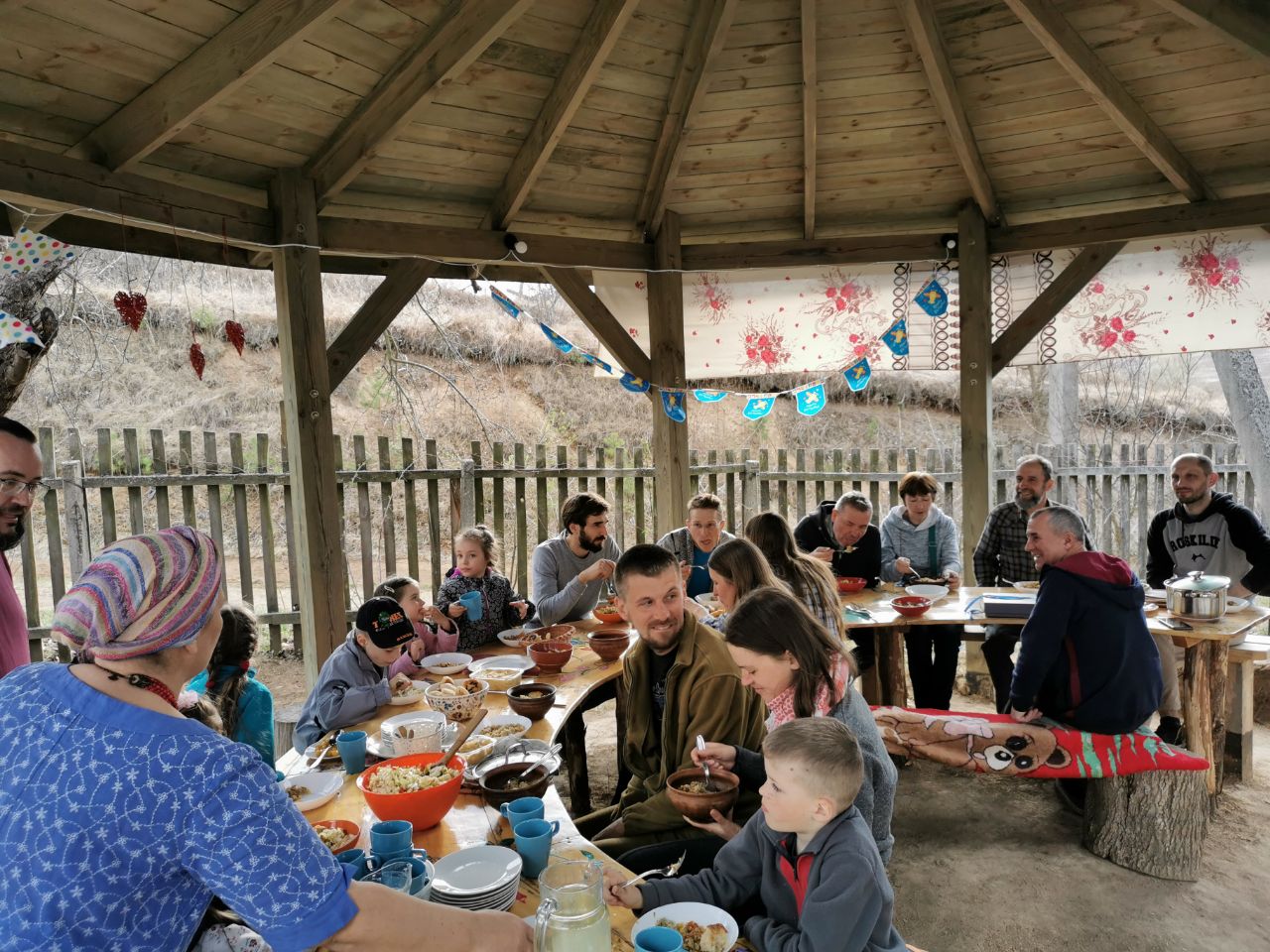
Common lunch of ecovillage people and refugees. NGO Gen/Ukraine
Before the war started, the two organizations already had networks of permaculture centers and ecovillages, and by now they have almost merged into one team. On the second day of the war, it became clear that many of their locations had abandoned houses with space to host displaced people. The houses were in various states of disrepair and in desperate need of restoration, but still, they were available and people needed shelter. How would members of the ecovillage network accomplish this with limited money and resources? Volkova and the head of the Global Ecovillage Network of Ukraine started to call people, and some villages encouraged guests to arrive straight away. The NGO heads knew villages might have enough supplies to host people for a month, but what if the war continued for longer?
They came up with a plan to take a map and pinpoint locations that wanted to host refugees. Then two organizations would collect and distribute funds, and the communities themselves would organize the accommodations. In the first month of the war, planning anything was almost impossible with the rapidly changing situation, and they continued to hope the invasion would soon end. But they wanted to host as many people as possible and Volkova suggested they might find places for 100 displaced Ukrainians. The GEN president pushed that goal to 1,000. For those leaving cities, they would offer refuge in rural ecovillage communities, with the map of locations—what they called the Green Road—some of which spilled out across the border for those who needed a place to stay as they fled conflict areas.
“In the beginning, ecovillages agreed to host other people without any problem because they thought the war would only last several weeks,” Volkova says. But the weeks turned to months, and now a network of ecovillages, permaculture centers, small farms, and individual homes have hosted thousands of displaced people in Ukraine. By the end of spring 2021, a digital map showed 100 ecovillages in Ukraine, but as the summer drew to a close and more people went abroad or areas fell under occupation, there were approximately 60 such places scattered throughout the whole country, from Kharkiv to Lviv, forming a corridor from cities and targeted areas of Ukraine into rural communities of relative safety.
People who want to stay within the country sought shelter in rural areas, while others crossed the border into Poland, Slovakia, and Hungary and followed the network’s path. Today there are more than 300 such locations across Europe, from Ukraine to Spain. Some displaced people move among the sites in Ukraine, gradually approaching the Western border with Poland, while others settled down in communities that became their new homes. Most of the travelers are women and children; men remain in the cities or are conscripted to fight in the army.
“In the first month, not many people wanted to go no further than Poland, Moldova, Romania, because everybody hoped to come back quickly,” Volkova says, “But then more and more people decided to go to Italy, Netherlands, to faraway countries.”
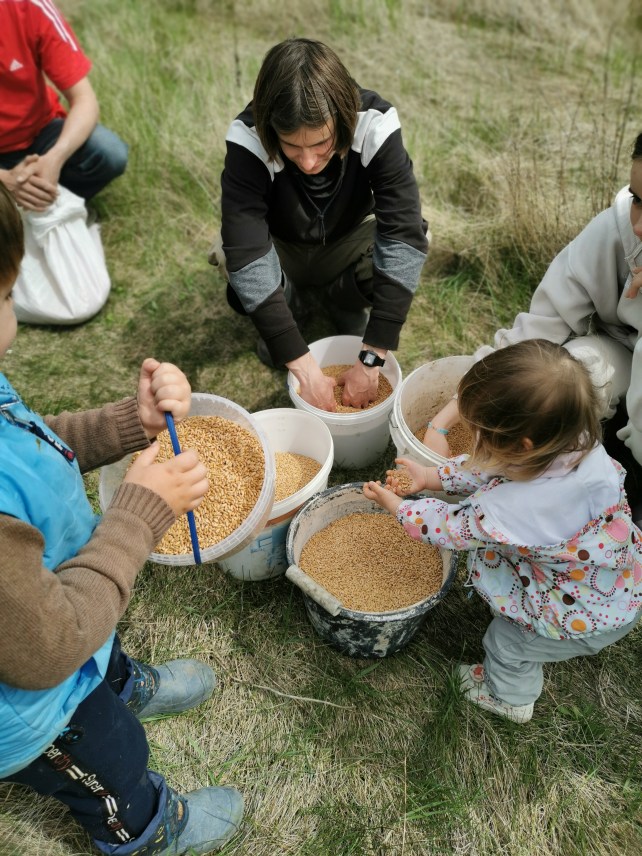
Seeding wheat in an ecovillage together with refugees. NGO Gen/Ukraine
Volkova initially thought the network in Ukraine would have the capacity to host about 200 people. “The numbers were rising, rising, and rising,” she says, “because a lot of people were using our locations to sleep one or two nights and to go further to the border.” In the days since, they have welcomed more than 3,000. Leaving home is never an easy thing to do—even when that home is being shattered by war. People often change their minds at the last moment. “You say okay, I will stay here,” she says, “The next day there are airplanes going around your house all day long. And you understand that you want to go abroad.”
Ecovillages have existed for decades, with the first major projects like Findhorn in Scotland and Auroville in India bursting onto the scene in the 1960s. The village Solheimar in Iceland dates back to the 1930s, explains Fran Whitlock, the communications manager of GEN Europe, the continent-wide network of which GEN Ukraine is a part. “The movement as we know it was really spearheaded by the co-founders of the Gaia Trust, Ross and Hildur Jackson,” Whitlock says. “Their experiences in kibbutzes and co-housing communities, as well as concern for environmental issues and economic inequality, led them to found the Gaia Trust in the late ‘80s to dedicate funds to communities creating models of sustainable living.”
Whitlock describes ecovillages as living laboratories, where societies can experiment with more peaceful, fair, and sustainable ways of living. “The tools developed in these experimental hubs can then be taken out into the world,” she says, “tools for community building, conflict resolution, fair governance, and creative waste reduction.”
On the day the war began, ecovillagers talked among themselves about how they could help: “Crucially, ecovillages are place-based communities that are used to hosting, so offering hospitality to those in need was both logistically and socially simplified,” Whitlock says.
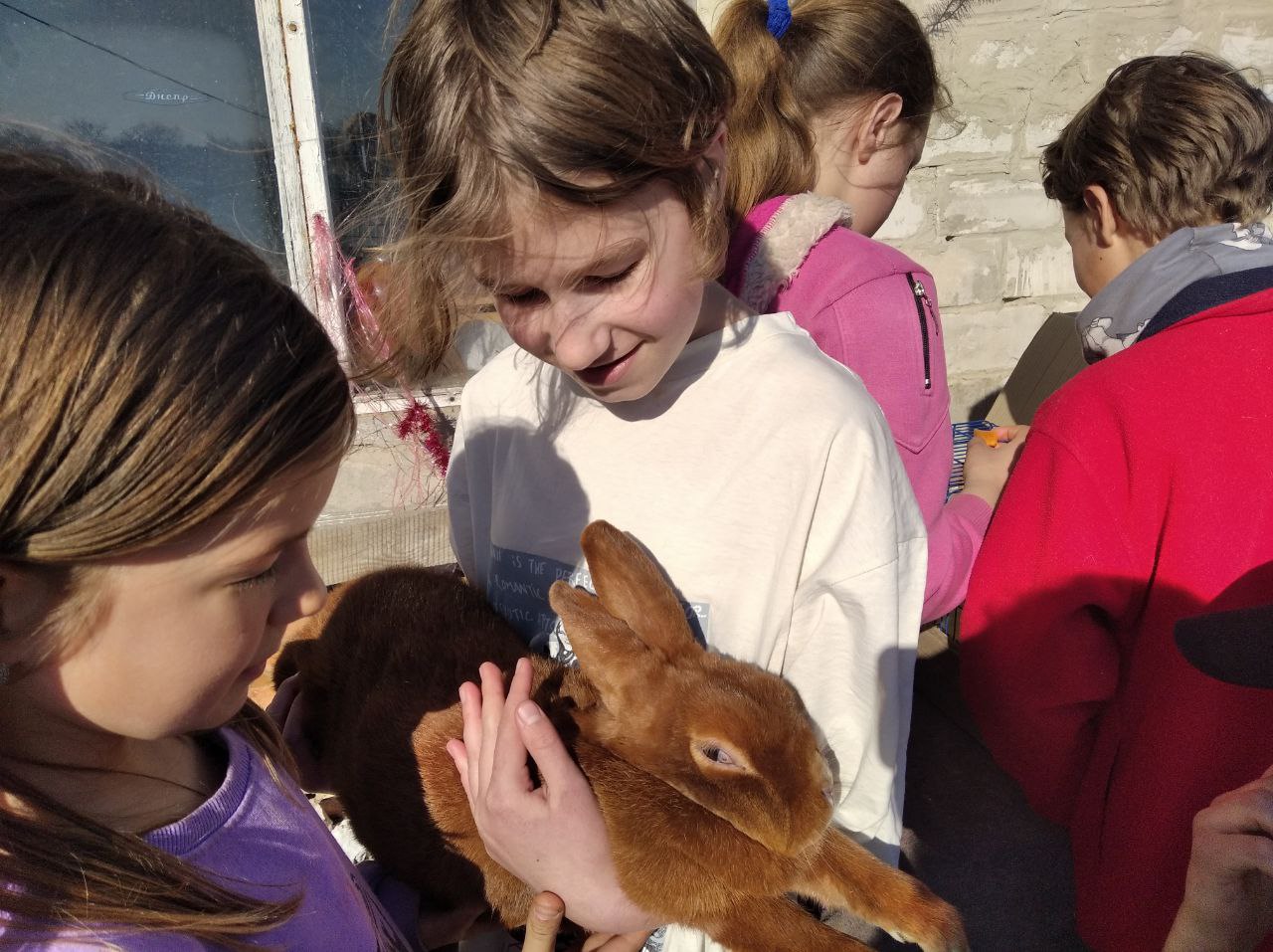
Rehabilitation for children with farm animals. NGO Gen/Ukraine
Denmark is one country closely tapped into the Green Road. Camilla Nielsen-Englyst works in the Danish network of GEN Europe and was part of the team that put everything in place, organizing ecovillages in Denmark, keeping connected with the network online, and talking to families who were waiting in long lines of cars at the border, securing them a place to stay on the other side.
“The first person to arrive was a mother with her two children. She is part of an ecovillage that I had been in myself, in Ukraine,” Nielsen-Englyst recalls, remembering how they were delivered to the Danish ecovillage by two elderly men driving a bus. Now Ukrainian guests are embedded in Danish communities. They attend Danish language classes, join working groups, and take cooking shifts. They celebrate birthdays together. “For us as an ecovillage community, it feels very meaningful to have our Ukrainian friends here. It brings the war closer, as we have living evidence among us every day that there is a war in Ukraine.”
For this network, what stood out about ecovillages, is that they already existed. They were ready to host people in some capacity, whereas other organizations took time to arrange themselves. “The ecovillage network during a crisis is an example of civil society cooperation at its best,” Nielsen-Englyst says. Now, their Ukrainian guests will have to decide their futures. When the war ends, will they return to their homes, or will they truly settle in Denmark?
Those who don’t want to leave Ukraine have found a measure of security in the ecovillages. Volkova’s eco-community is made up of a collection of houses spread throughout a normal Ukrainian village. They breathe new life into the village, which is largely occupied by elderly residents. Each family owns its own house and garden — her ecovillage has 12 homes in total, along with a hostel that has been coopted to house refugees. They grow rye and wheat on communal fields and share an orchard.
Other ecovillages are purpose-built, transformed from farmsteads, or on the outskirts of existing villages. Some villages keep goats and horses, while others practice traditional techniques like willow weaving and sewing. While the landscape and structures vary, the focus on living in harmony with the natural world prevails. In a survey carried out by the Green Road locations last fall, around 650 people across Ukraine were planning to stay for the winter. A new family arriving in Anastasiya’s ecovillage near the beginning of the invasion decided to buy their own home there.
Animals are also victims of war and in need of protection and care. Near the city of Dnipro, one farm in the network has welcomed more than 700 animals —from dogs and rabbits to horses and cows — left homeless by the conflict. Internally displaced children and adults from nearby occupied territories visit on what the farm owners call “rehabilitation days,” during which they have a chance to spend time with the rescued animals and each other— they are calmed by stroking a rabbit’s fur, or reassured as they hold their hand against the powerful neck of a horse. For people who’ve been in combat zones, who have made difficult decisions and seen horrors, there is more to refuge than shelter. Psychologists are on hand within the network, and regular calls between coordinators ensure people get the support they need.
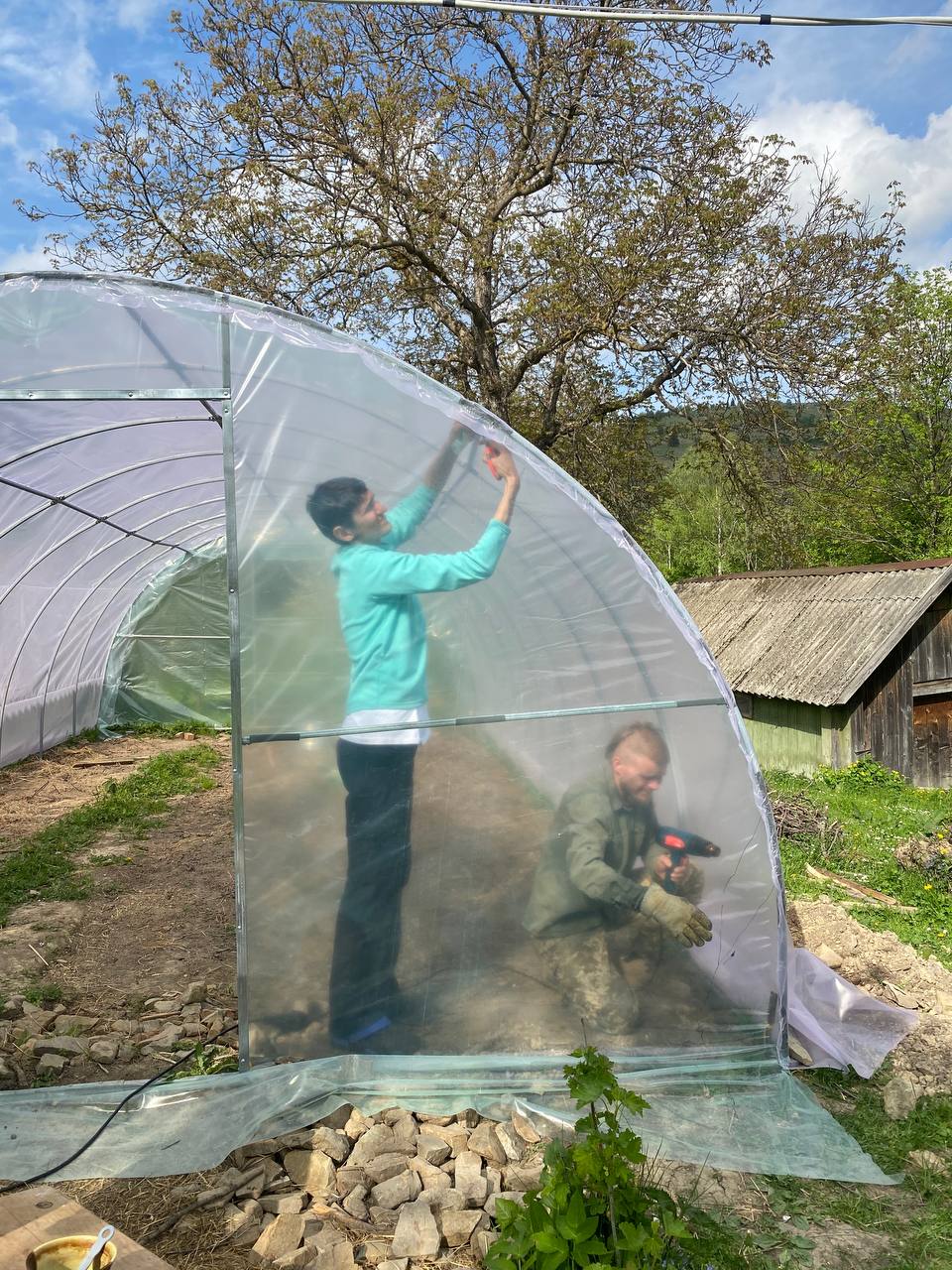
Installation of one of the 35 greenhouses that were bought for the locations of the Green Road. NGO Permaculture/Ukraine
Ecovillages, however, were not organized to address needs during a war, but now organizers are finding that this is what is happening. The houses in need of repair are not pretty countryside cottages ready for families, but little more than gray concrete walls, bare lightbulbs, and empty rooms. For the most part, these houses have been abandoned by locals and stood empty for years. Ecovillagers in the Green Road network got to work cleaning, finding mattresses, and sourcing fuel and food. They carried refrigerators through snow, rollered paint onto drab walls, and used horses to transport greenhouses. They connected homes with water, changed old wires, and bought huge tanks to harvest rainwater. With international support, they covered these basics, before turning their attention to issues of sustainability.
In ecovillages, people grow their own food and are used to living with fewer resources, but more mouths to feed means the need for more crops. As the war enters its second year, food security becomes an even tougher challenge, with supply chains completely destroyed across the country. Self-reliance is all the more important, but that comes with new challenges too. In Volkova’s own village, turning wheat into flour has become impossible, as many local industries are closed. Machines are too expensive to buy for themselves, so their harvested produce sits in sacks.
Growing food helps, but it doesn’t cover every need. The shattered Ukrainian economy has left many people unemployed. In Volkova’s community, she says nobody has any income at the moment. The coordinating team has found that answering the immediate needs of displaced people with shelter and food can burden the communities that host them.
To expand the economic base, they’re trying to find new ways for people to earn an income and become more economically independent. In Volkova’s own community, the answer could be beehives. During the hives’ first year, the bees made enough honey for the villagers to share with each other and with family, and the insects are now hibernating. Volkova hopes that in future years, they will start generating money from the produce. In other regions, the network purchased tractors to help people better prepare the land, and so grow extra food to sell. Owners of some permaculture centers are growing seeds for people living in occupied areas. Just like people, seedlings travel through the Green Road network, as people share what they have. There is a balcony food-growing project for others. But generating a living income continues to be a problem both for displaced people and for the communities that host them.

Renovating old houses to host people. NGO Permaculture/Ukraine
Before the war, Permaculture in Ukraine had a very different mission, offering courses, organizing scientific international conferences, and translating permaculture books into the Ukrainian language. They created permaculture designs for individuals. “Now, many things that we were dreaming of before the war are coming true,” Volkova says. “We as a network became very strong and powerful because there are now more people who came to live in our ecovillages, and now we have more resources.”
Pavlo Ardanov, the Deputy Head and Research Coordinator for Permaculture Ukraine is working from Germany, drawing on his experience of organizing medical support for protesters during the 2013 revolution to now coordinate supplies and humanitarian aid in Ukraine. He notes that “there is a severe lack of first aid kits for people who join army forces or territorial defenses.” So the organization expanded its scope of activities and used its infrastructure to provide these first aid kits for communities and combatants.
Within the first few months of the invasion, Permaculture in Ukraine joined forces with the UK-based Permaculture Association and Permaculture Magazine to set up crowdfunding, raising around $20,400 for the purchase of 270 first aid kits buying 270 kits.
The initial plan was to support permaculturists serving in the armed forces, but this wasn’t enough. Requests came from everywhere, to begin with and Ardanov grappled with raising enough money for expensive first aid kits, finding suppliers who still had stock, and getting global deliveries quickly sent to Ukraine. With dwindling supplies, he says that some companies increased their prices.
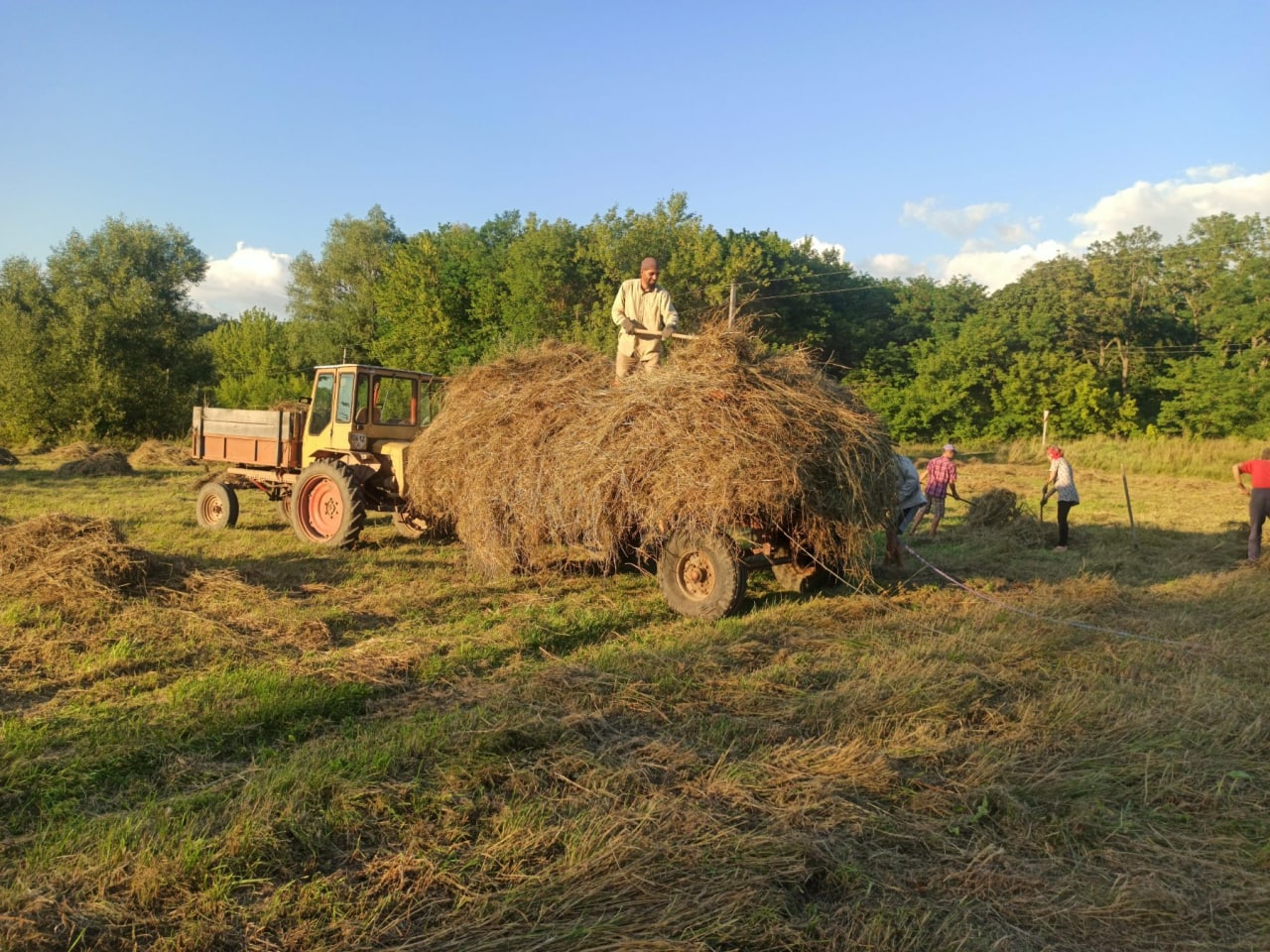
Making stocks of hay for the animals in Charivne ecovillage, Cherkassy region. NGO Permaculture/Ukraine
Now the team is attempting to tackle the considerable problem of energy blackouts through solar power, increasing food production for income, and helping people develop soft skills, all while raising the funds to support people (and farm animals) seeking safety on the Green Road. But as the days go on, nothing is certain. One moment they were safe in Ukraine, the next Russian bombs were falling.
“Nobody believed in it, that it would happen,” remembers Volkova. “All of us were sure that they will decide it on some political level, and that in the 21st century, in a European country, it is not possible that bombs are really falling on our houses. And when the war began, we were all sure that it would last some days. Some weeks. But now we were not sure about anything.”
Volkova still lives in her ecovillage home with her husband and daughter, with her parents a few doors away.
“I remember one thought that I had on the first day when we arrived here, that I will have nothing to do. There will be no more projects, and I will have a lot of free time to spend with my daughter,” she remembers. Laughing, she says she was wrong about that.
